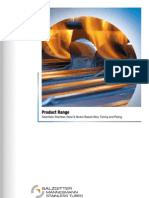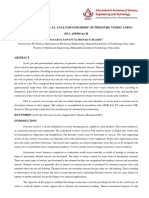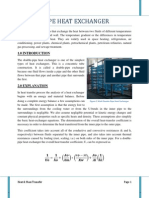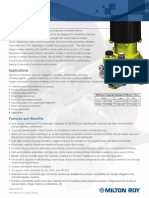Double Pipe Heat Exchanger
Double Pipe Heat Exchanger
Uploaded by
harisCopyright:
Available Formats
Double Pipe Heat Exchanger
Double Pipe Heat Exchanger
Uploaded by
harisOriginal Description:
Original Title
Copyright
Available Formats
Share this document
Did you find this document useful?
Is this content inappropriate?
Copyright:
Available Formats
Double Pipe Heat Exchanger
Double Pipe Heat Exchanger
Uploaded by
harisCopyright:
Available Formats
Double Pipe Heat Exchanger
DOUBLE PIPE HEAT EXCHANGER
Heat exchangers are devices that exchange the heat between two fluids of different temperatures
that are separated by a solid wall. The temperature gradient or the differences in temperature
facilitate this transfer of heat. They are widely used in space heating, refrigeration, air
conditioning, power plants, chemical plants, petrochemical plants, petroleum refineries, natural
gas processing, and sewage treatment.
1.0 INTRODUCTION
The double-pipe heat exchanger is one of the simplest
types of heat exchangers. This is a concentric tube
construction. It is called a double-pipe exchanger
because one fluid flows inside a pipe and the other fluid
flows between that pipe and another pipe that surrounds
the first.
2.0 EXPLANATION
In heat transfer process the analysis of a heat exchanger
begins with an energy and material balance. Before
doing a complete energy balance a few assumptions can Figure 1 Multi Double Pipe Heat Exchanger
be made. The first assumption is that the energy lost to
the surroundings from the cooling water or from the U-bends in the inner pipe to the
surroundings is negligible. We also assume negligible potential or kinetic energy changes and
constant physical properties such as specific heats and density. These assumptions also simplify
the basic heat-exchanger equations. The determination of the overall heat-transfer coefficient is
necessary in order to determine the heat transferred from the inner pipe to the outer pipe.
This coefficient takes into account all of the conductive and convective resistances (k and h,
respectively) between fluids separated by the inner pipe, and also takes into account thermal
resistances caused by fouling (rust, scaling, i.e.) on both sides of the inner pipe. For a double-
pipe heat exchanger the overall heat transfer coefficient, U, can be expressed as
( ) ( ) ( )
Heat & Mass Transfer Page 1
Double Pipe Heat Exchanger
2.1 HEAT DUTY
It is the heat transfer with respect to the time of the flow of fluid in heat exchanger.
3.0 CONTRUCTION
The double pipe heat exchanger is constructed by using metals or alloys that have good heat
resistance and corrosive resistance properties. Normally the size of double pipe heat exchanger is
between 100 200 ft2.
Figure 2 Cross-Sectional view of Double Pipe Heat Exchanger
3.1 EQUIPMENTS
The following is a list of all pieces of equipment for the double-pipe heat exchanger.
Pump
Double pipe heat exchanger
Valves
o Gate valves
o Disk blow valves
o Ball valves
o Computer controlled valves
Flow meters
Thermocouples
Low pressure steam
Computer
Heat & Mass Transfer Page 2
Double Pipe Heat Exchanger
4.0 FLUID MOVEMENT
There are two flow configurations co-current is when the
flow of the two streams is in the same direction, counter
current is when the flow of the streams is in opposite
directions.
4.1 COUNTER CURRENT FLOW
Fluids flow in opposite directions. These are used for
liquid-liquid, condensing and gas cooling applications. Figure 3 Tubular Heat Exchanger
Usually the counter current movement is used as the rate of
heat transfer is more as compared to co-current movement.
4.2 CO-CURRENT FLOW
In the concurrent flow exchange
mechanism, the two fluids flow in the
same direction. This type of flow is
usually used when the less heat transfer is
required. The co-efficient of heat transfer
is low in co-current flow.
Figure 4 Concurrent and countercurrent flow
5.0 MAINTENANCE
Maintenance of commercial heat exchangers is done by tracking the overall heat transfer
coefficient. The overall heat transfer coefficient tends to decline over time due to fouling.
By periodically calculating the overall heat transfer coefficient from exchanger flow rates and
temperatures, the owner of the heat exchanger can estimate when cleaning the heat exchanger
will be economically attractive.
Heat & Mass Transfer Page 3
Double Pipe Heat Exchanger
5.1 FOULING
Fouling occurs when impurities deposit on the heat
exchange surface. Deposition of these impurities can
be caused by the following factors
Low wall shear stress
Fluid velocity
Fluid precipitation
Suspended particles in fluid
Impurities in fluid
Reaction with exchanger material and fluid
Other pressure and temperature conditions Figure 5 Fouling
6.0 APPLICATIONS
Double pipe heat exchanger utilizes true counter-current flow to which maximizes the
temperature differences between the shell side and the tube side fluids, resulting in less
surface area required for a given duty.
Double Pipe exchangers are especially suitable for extreme temperature crossing, high
pressure, high temperature, and low to moderate surface area requirements. So when your
process calls for a temperature cross when the hot fluid outlet temperature is below the
cold fluid outlet temperature, a hairpin heat exchanger is the most efficient design and
will result in fewer sections and less surface area.
Double-pipe heat exchangers use a single pipe within a pipe design and are commonly
used for high fouling services such as slurries, where abrasive materials are present, and
for smaller duties. Standard shell diameters typically range from 2 to 6.
In commercial aircraft heat exchangers are used to take heat from the engine's oil system
to heat cold fuel. This improves fuel efficiency, as well as reduces the possibility of water
entrapped in the fuel freezing in components.
The classic example of a heat exchanger is found in an internal combustion engine in
which a circulating fluid known as engine coolant flows through radiator coils and air
flows past the coils, which cools the coolant and heats the incoming air.
Heat & Mass Transfer Page 4
Double Pipe Heat Exchanger
7.0 ADVANTAGES
Easy to operate.
Counter currents are obtained easily.
It can withstand high pressure and temperature.
Modular structure.
Maintenance is easy and repairing also easy
Easily displace from one place to another if required.
It can be adjusted according to the process need.
Occupy less space.
Structure is simple and heat transmission is large.
Provides shorter deliveries than shell and tube due to standardization of design and
construction.
Many suppliers are available worldwide
8.0 DISADVANTAGES
Double pipe heat exchanger is expensive for heavy duties.
The use of two single flow areas leads to relatively low flow rates and moderate
temperature differences.
Cant be used in handling dirty fluids.
It is difficult to readily inspect the shell side of the tubes for scaling or tube damage.
9.0 CONCLUSION
As the consequences of the above mentioned detailed properties, applications advantages and
disadvantages the double pipe heat exchanger is used according to the needs of the process in
industry as well as other heat exchanging processes.
Heat & Mass Transfer Page 5
Double Pipe Heat Exchanger
REFERENCES
http://www.scribd.com/doc/56011858/4/DOUBLE-PIPE-HEAT-EXCHANGERS
http://en.wikipedia.org/wiki/Heat_exchanger#Applications
http://brazedplateheatexchangers.wordpress.com/2010/03/01/shell-and-tube-heat-exchanger-
advantages-and-disadvantages/
http://wiki.answers.com/Q/What_are_the_Advantage_and_disadvantages_of_double_pipe_he
at_exchanger
Emerson Process Management product guide.http://www.emersonprocess.com/ brooks/
products/products3d.html (accessed Sept 2002).
deNevers, N., Fluid Mechanics, McGraw Hill, (1991).
Heat & Mass Transfer Page 6
You might also like
- Graphite Heat ExchangersDocument9 pagesGraphite Heat ExchangersRehinaNo ratings yet
- Heat ExchangersDocument14 pagesHeat ExchangersAdrian StoicescuNo ratings yet
- Double Pipe Heat ExchangersDocument27 pagesDouble Pipe Heat ExchangersDURGA KASTURINo ratings yet
- Types of Heat ExchangersDocument14 pagesTypes of Heat ExchangersMuhammadFahadIjazNo ratings yet
- Designn of Heat ExchangerDocument53 pagesDesignn of Heat ExchangerBalu BalireddiNo ratings yet
- Ideas To Achieve Optimal Combination of Axial & Cross FlowDocument28 pagesIdeas To Achieve Optimal Combination of Axial & Cross FlowAmirah SufianNo ratings yet
- Project PPT of Heat ExchangerDocument18 pagesProject PPT of Heat ExchangerGaurav Thakkar50% (2)
- Double Pipe Heat ExchangerDocument7 pagesDouble Pipe Heat ExchangerPriyanshiVadaliaNo ratings yet
- Heat Exchanger FinalDocument35 pagesHeat Exchanger Finalshabirahsan79No ratings yet
- Heat ExchangerDocument44 pagesHeat Exchangerweldy puteraNo ratings yet
- ALFA LAVAL Compact Heat Exchangers in HVAC SystemsDocument27 pagesALFA LAVAL Compact Heat Exchangers in HVAC SystemsvickersNo ratings yet
- Heat Exchanger Types and SelectionDocument31 pagesHeat Exchanger Types and Selectionmehul10941No ratings yet
- Heat Exchangers: Submitted To: Mr. AtifDocument12 pagesHeat Exchangers: Submitted To: Mr. Atifmak412No ratings yet
- Heat ExchangersDocument47 pagesHeat Exchangersmohammed alaa eldinNo ratings yet
- HT Heat ExchangerDocument17 pagesHT Heat Exchangerpatel jatinNo ratings yet
- Heat Exchanger DataDocument7 pagesHeat Exchanger DataTHE SEZARNo ratings yet
- Heat Exchangers ReportDocument16 pagesHeat Exchangers Report刘羿村No ratings yet
- Heat Exchanger2009 Proposal#1Document318 pagesHeat Exchanger2009 Proposal#1HarryBouter100% (1)
- Cladding in Heat Exchanger - BaherDocument3 pagesCladding in Heat Exchanger - BaherWael MansourNo ratings yet
- Boiler Components FunctionDocument2 pagesBoiler Components FunctionMuhammad Adli Bin Ja'affarNo ratings yet
- Cryogenic TanksDocument3 pagesCryogenic TanksRupali Ghodekar GorivaleNo ratings yet
- SMST-Tubes Product Range en 2010 WebDocument16 pagesSMST-Tubes Product Range en 2010 Webalbejo_r9No ratings yet
- Tube Layout DrawingDocument1 pageTube Layout DrawingAnonymous AyDvqgNo ratings yet
- Recent Trend in Heat ExchangerDocument9 pagesRecent Trend in Heat Exchangersai100% (1)
- Air Cooled Heat ExchangerDocument1 pageAir Cooled Heat Exchangermuhammadtayyab_87No ratings yet
- Reboiler, Vaporator, EvaporatorDocument43 pagesReboiler, Vaporator, EvaporatorMARCELINO BRILLIANT ISWANTONo ratings yet
- Heat Exchanger ComponentsDocument3 pagesHeat Exchanger ComponentsKarthik AnandanNo ratings yet
- Aer 423 ManualDocument45 pagesAer 423 ManualRahul TripathiNo ratings yet
- AP Government GATE Online Classes: Heat TransferDocument88 pagesAP Government GATE Online Classes: Heat TransferRohan lallNo ratings yet
- Boundary LayerDocument12 pagesBoundary Layerhayder alaliNo ratings yet
- Criteria For Selecting Heat ExchangerDocument7 pagesCriteria For Selecting Heat ExchangerKashaf TehreemNo ratings yet
- Individual Solutions: Air-Cooled Heat ExchangersDocument22 pagesIndividual Solutions: Air-Cooled Heat ExchangersMiguel SoteloNo ratings yet
- Sthe SSDocument43 pagesSthe SSNathanianNo ratings yet
- Introduction To BoilersDocument36 pagesIntroduction To BoilersAdel SukerNo ratings yet
- Steam Power Plants-IIDocument96 pagesSteam Power Plants-IInaga sNo ratings yet
- Shell and Tube Heat Exchanger DesignDocument5 pagesShell and Tube Heat Exchanger DesignDominic CareoNo ratings yet
- Heat ExchangerDocument20 pagesHeat ExchangerankitNo ratings yet
- Design Considerations For Compact Heat ExchangersDocument16 pagesDesign Considerations For Compact Heat ExchangersHaunted HunterNo ratings yet
- Wiley - Heat Exchanger Design, 2nd Edition - 978!0!471-62868-2Document1 pageWiley - Heat Exchanger Design, 2nd Edition - 978!0!471-62868-2TECH ARM MALAYALAMNo ratings yet
- Air Cooler Piping Design Questionaries With AnswerDocument1 pageAir Cooler Piping Design Questionaries With AnswerVikash TiwariNo ratings yet
- (Unit Operations Laboratory-2) : Name: Siraj Ali Aldeeb ID: 3214118Document7 pages(Unit Operations Laboratory-2) : Name: Siraj Ali Aldeeb ID: 3214118Siraj AL sharifNo ratings yet
- Double Pipe Heat Exchanger Design - ChE GuideDocument6 pagesDouble Pipe Heat Exchanger Design - ChE GuideNastaran BagheriNo ratings yet
- Air CoolerDocument13 pagesAir CoolerMina RemonNo ratings yet
- Heat ExchangerDocument58 pagesHeat ExchangercanyourunNo ratings yet
- 11 Heat Transfer To The Riser Wall of A Circulating Fluidised Bed CFBDocument8 pages11 Heat Transfer To The Riser Wall of A Circulating Fluidised Bed CFBMahesh DasarNo ratings yet
- Heat Exchangers Review StudyDocument11 pagesHeat Exchangers Review StudyDharmendra PrajapatiNo ratings yet
- PED Ch2Document30 pagesPED Ch2Shubham KumarNo ratings yet
- Welding of Pressure VesselsDocument2 pagesWelding of Pressure VesselsDvida PleasureNo ratings yet
- Bubble ColumnDocument34 pagesBubble ColumnAfroz MohammedNo ratings yet
- Shell and Tube Heat ExchangersDocument11 pagesShell and Tube Heat ExchangersSuresh SjNo ratings yet
- Heat Exchanger (New)Document38 pagesHeat Exchanger (New)Rochie DiezNo ratings yet
- Air-Cooled Heat Exchangers: LectureDocument39 pagesAir-Cooled Heat Exchangers: LectureBaraa Shurbaji No 111No ratings yet
- Shell and Tube Heat ExchangersDocument27 pagesShell and Tube Heat Exchangersalibaba011No ratings yet
- Heat ExchangerDocument34 pagesHeat ExchangerMaria Cecille Sarmiento GarciaNo ratings yet
- BreechLock HEDocument1 pageBreechLock HEibrahim1961No ratings yet
- Hot Box Design PDFDocument8 pagesHot Box Design PDFAbu Anas M.SalaheldinNo ratings yet
- Double Pipe Heat ExchangerDocument6 pagesDouble Pipe Heat ExchangerKhaqan Amin50% (8)
- Heat Exchanger DesignDocument13 pagesHeat Exchanger DesignDaksh Parashar83% (6)
- The DoubleDocument2 pagesThe DoubleharisNo ratings yet
- Heat Exchanger Important DocumentDocument126 pagesHeat Exchanger Important DocumentUsamaAli100% (1)
- ASDEO KPPSCDocument4 pagesASDEO KPPSCharisNo ratings yet
- Isomerization TechniqueDocument14 pagesIsomerization TechniqueharisNo ratings yet
- The DoubleDocument2 pagesThe DoubleharisNo ratings yet
- Polymers and Their PropertiesDocument16 pagesPolymers and Their PropertiesharisNo ratings yet
- Sizing MaterialsDocument45 pagesSizing Materialsharis0% (1)
- Heat B SettingDocument18 pagesHeat B SettingharisNo ratings yet
- Unit 3 - Basic Mechanical Engineering - WWW - Rgpvnotes.inDocument14 pagesUnit 3 - Basic Mechanical Engineering - WWW - Rgpvnotes.inrashmijammu8687No ratings yet
- Open Channel Flow FilledDocument65 pagesOpen Channel Flow FilledDarek Haile100% (1)
- Compressir Lubrication Theory DanfossDocument7 pagesCompressir Lubrication Theory DanfossSlavikNZNo ratings yet
- Mass Transfer-1Document38 pagesMass Transfer-1shahzadali0786No ratings yet
- ChemlabDocument4 pagesChemlabwelson100% (3)
- Aop b3 b6 IomDocument2 pagesAop b3 b6 IomrjNo ratings yet
- Pipe Stress AnalysisDocument51 pagesPipe Stress AnalysisTharun Reddy67% (3)
- VorticityDocument3 pagesVorticityUjjwal shuklaNo ratings yet
- DDPMC: Preventive Maintenance ChecklistDocument22 pagesDDPMC: Preventive Maintenance Checklistrobhgel jun marigonNo ratings yet
- Ass 2 CombengDocument4 pagesAss 2 CombengFrancis DacutananNo ratings yet
- Refrigeration and Air Conditioning PDFDocument33 pagesRefrigeration and Air Conditioning PDFgauravkumar bhandariNo ratings yet
- 13 LectureSlidesDocument141 pages13 LectureSlidesOnur YavuzcetinNo ratings yet
- Smallest Physical Size: Under 50 MicronsDocument1 pageSmallest Physical Size: Under 50 MicronsDaniel RestrepoNo ratings yet
- Fluids and ThermalDocument2 pagesFluids and ThermalKendrick GoNo ratings yet
- Chapter 3 WastewaterDocument115 pagesChapter 3 WastewaterNur Iffatin100% (1)
- Numerical Modeling of Gmaw ArcDocument2 pagesNumerical Modeling of Gmaw Arcpradeep benedictNo ratings yet
- 05 - Circuit DiagramsDocument82 pages05 - Circuit DiagramsJarrod DebonoNo ratings yet
- Hydro Cracking SolverDocument10 pagesHydro Cracking SolverDriss EddeniaNo ratings yet
- Clint Over Prodotti ENG-GREEK 2018 WDocument2 pagesClint Over Prodotti ENG-GREEK 2018 WlibegradNo ratings yet
- Working Principle of Vortex FlowmeterDocument4 pagesWorking Principle of Vortex FlowmetersandystaysNo ratings yet
- Use. Recover. Repeat.: Innovative Equipment SolutionsDocument12 pagesUse. Recover. Repeat.: Innovative Equipment SolutionsAnonymous Hh0I7OxpNo ratings yet
- KSB OmegaDocument2 pagesKSB OmegaAnne 90No ratings yet
- Energies: Temperatures and Heat Flows in A Soil Enclosing A Slinky Horizontal Heat ExchangerDocument16 pagesEnergies: Temperatures and Heat Flows in A Soil Enclosing A Slinky Horizontal Heat ExchangerLyf AquaNo ratings yet
- Self-Assessment FormDocument10 pagesSelf-Assessment FormKushal singhNo ratings yet
- Mroy Metering Pumps Data Sheet - 2022Document5 pagesMroy Metering Pumps Data Sheet - 2022Ricardo VeraNo ratings yet
- Wilo Datasheet - International - en - 2171231 - Cronoline Il 100 145 1 1 4 s1Document5 pagesWilo Datasheet - International - en - 2171231 - Cronoline Il 100 145 1 1 4 s1suwono radukNo ratings yet
- Guide To Refinery ProcessDocument131 pagesGuide To Refinery Processvazzoleralex6884100% (2)
- FTFS Chap23 P054Document34 pagesFTFS Chap23 P054AbdulAbdulNo ratings yet
- 01 Brochure Accessories enDocument3 pages01 Brochure Accessories enDxrazvanNo ratings yet
- Pipe Friction Loss CalculationDocument5 pagesPipe Friction Loss Calculationapi-26699613100% (6)






























































































